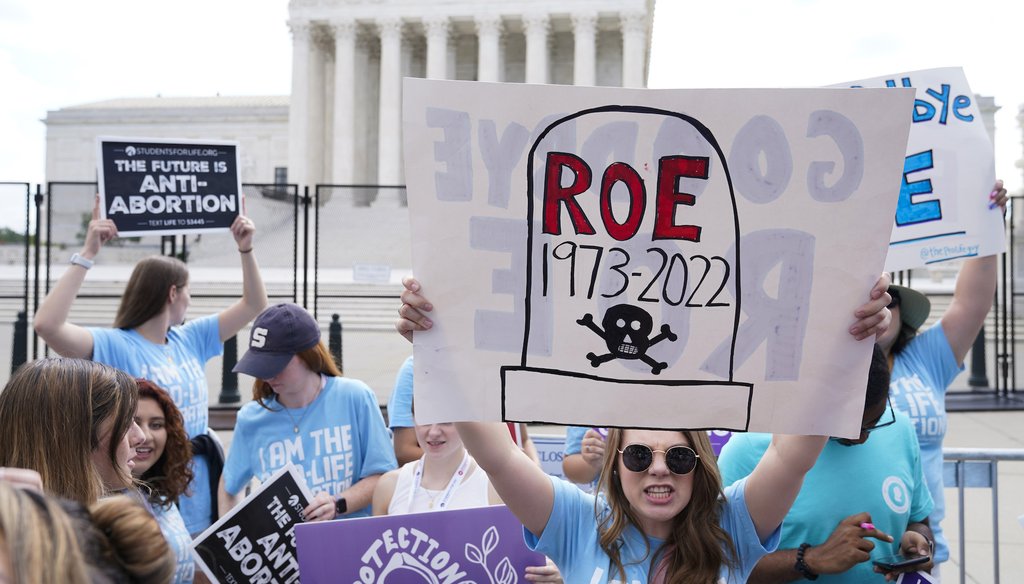Get PolitiFact in your inbox.

Demonstrators protest about abortion outside the Supreme Court in Washington on June 24, 2022. (AP Photo/Jacquelyn Martin)
If Your Time is short
-
Ohio’s abortion law outlaws the procedure once a “fetal heartbeat” is detected, which can be as early as six weeks into a pregnancy.
-
The law provides exceptions, allowing the procedure to prevent the death of the mother or to “prevent a serious risk of the substantial and irreversible impairment of a major bodily function.”
-
Experts say the law’s language is too vague to be certain that it would have applied to a 10-year-old rape victim.
The story of a 10-year-old Ohio girl who was raped, impregnated and then traveled to Indiana to receive an abortion gained national attention after President Joe Biden expressed his dismay earlier this month.
The girl was forced to travel for the procedure due to Ohio’s "fetal heartbeat law," but some expressed doubts the story was real — until a 27-year-old man was arrested and charged in her assault. Now, some are arguing that under the Ohio law, the girl could have actually obtained an abortion without leaving the state.
"Under Ohio law, the little girl would not have been denied emergency medical services," conservative podcaster Tim Pool said in an episode of his podcast (at the 1:48 mark) shared on Facebook.
To back his claim, Pool cited a statement from Ohio Attorney General Dave Yost that Pool said broke down "what the law actually said." Pool suggested, without evidence, that the girl was taken to Indiana for the procedure "for political gain," instead of trying to have it done in Ohio.
Yost initially questioned the validity of the story in a July 11 interview on Fox News, telling host Jesse Watters that "Ohio’s heartbeat law has an emergency medical exception broader than just the life of the mother." He said the girl "did not have to leave Ohio to find treatment."
After news of an arrest in the girl’s rape a couple of days later, Yost’s office issued what it called a "legal explainer" about what it said are three exceptions in Ohio’s abortion law that include the life of the mother, the serious risk of irreversible damage to a major bodily function, and an ectopic pregnancy.
But experts we spoke with say the law as written is not as clear as the attorney general suggested on Fox News. The law is ambiguous about whether the young girl in this case could have gotten the procedure in Ohio without a provider facing legal penalties.
"A doctor could make a plausible argument that a 10-year-old rape victim like the child who went to Indiana could qualify for an exception," said Anthony Michael Kreis, an assistant professor of law at Georgia State University. "But legal plausibility is a dangerous zone to practice medicine when you're staring down the serious consequences of the law if lawyers without medical training disagree with you."
What Ohio’s abortion law says
Ohio’s 2019 law, which had been tied up in court but was reimposed after Roe v. Wade was overturned, outlaws abortions once a fetal heartbeat has been detected. A doctor who induces an abortion once a heartbeat is detected could face fifth-degree felony charges.
The law doesn’t cite a specific gestation period, but experts say that it is possible to detect a fetal heartbeat as early as six weeks. The law does not provide an exception for rape or incest.
The section of the law about penalties states in part that it:
"does not apply to a physician who performs a medical procedure that, in the physician's reasonable medical judgment, is designed or intended to prevent the death of the pregnant woman or to prevent a serious risk of the substantial and irreversible impairment of a major bodily function of the pregnant woman.
If an abortion is done under this criteria, the doctor must fill out a document specifying the "medical condition that the abortion is asserted to address and the medical rationale for the person's conclusion that the abortion is necessary to address that condition."
In Yost’s explainer, he points to a part of the Ohio code that he said defines what would be considered a "serious risk of the substantial and irreversible impairment of a major bodily function." That section, seen below, does not describe any specific dangers a young child might face giving birth, and specifically excludes mental health. Yost’s explainer notes that the definition is an illustration and that more conditions may be applicable. It reads:
(K) "Serious risk of the substantial and irreversible impairment of a major bodily function" means any medically diagnosed condition that so complicates the pregnancy of the woman as to directly or indirectly cause the substantial and irreversible impairment of a major bodily function. A medically diagnosed condition that constitutes a "serious risk of the substantial and irreversible impairment of a major bodily function" includes pre-eclampsia, inevitable abortion, and premature rupture of the membranes, may include, but is not limited to, diabetes and multiple sclerosis, and does not include a condition related to the woman's mental health.
What health risks would a young child face in childbirth?
There are several risks for a young child carrying a fetus to term, experts said.
The World Health Organization said that complications from pregnancy and childbirth are the leading cause of death for girls ages 15-19 globally, mostly in poor countries. It also said that girls ages 10 to 19 "face higher risks of eclampsia, puerperal endometritis (an infection in the lining of the uterus after giving birth) and systemic infections" than mothers in their early 20s.
"A 10-year-old may technically be able to carry a pregnancy, but most have not completed skeletal growth, which means that most have not completed growth of the pelvis to an adult size," said Dr. Anne-Marie Amies Oelschlager, vice chair of the American College of Obstetricians and Gynecologists’ Clinical Consensus Committee – Gynecology. "This definitely would increase the risk of pregnancy to this child."
Amies Oelschlager said pregnancy can happen prior to a child’s first period, so a young girl may not know they are pregnant prior to six weeks of gestation, when fetal heart motion is often seen on ultrasounds. For that reason, the law is "especially onerous for adolescents," she said.
Amies Oelschlager cited a study showing an increased risk to the health of the child’s fetus, such as premature birth, low birth weight and a higher risk of infant death.
Is that enough to qualify for an exemption?
"I do not blame the care providers in Ohio who are afraid that they would be prosecuted," Amies Oelschlager said. "It is clearly stated that they would be committing a felony if they do not meet this vague criteria."
She also said a case like this could have a devastating effect on a young child’s mental health. The law, however, specifically excludes mental health as an exception for an abortion.
Cases like the one involving the 10-year-old may not be that rare as people adjust to new laws restricting abortions in 22 states, as of July 20, since the Supreme Court ruling.
Ohio’s public health department reported 52 abortions in children under 15 in 2020, down from 182 in 2010. The Guttmacher Institute, a nonprofit research organization supporting abortion rights, reported that in 2017, its latest year of available data, there were 4,460 girls under 15 who were pregnant in the U.S., a number that has also steadily decreased over the years. Of those, 1,960, or about 44%, resulted in abortions.
It’s not known whether sexual assault was a factor in those pregnancies, but Amies Oelschlager said it’s not uncommon.
"I have cared for hundreds of patients who were sexually assaulted in adolescence and much younger," she said. "The long shadow of this trauma in their lives is hard for me to convey in words."
What legal experts say
We spoke with several legal experts who agreed the law is not clear on medical exceptions and whether they would have applied in the case of this 10-year-old girl. And, they said, because the law is new and courts have not weighed in yet, it’s not certain how judges might interpret the statute.
Tracy Thomas, director of the Center for Constitutional Law and a professor at the University of Akron, said "vagueness is a major problem" with this and similar state abortion laws.
"Since this language that appears in Ohio, and some other states with slight differences, like Texas and Missouri, is new and not enforced until Dobbs overturned Roe, we have not yet seen exactly how the courts will interpret the language," Thomas said.
She said it’s clear that the language "is meant to be something more strict than the pre-Roe laws allowing abortion for ‘medical necessity,’" which she said gave doctors wide discretion.
"It seems to require a pretty extreme medical situation close to permanent disability," said Thomas, who said she didn’t think the law as written would apply to the 10-year-old girl. "The particularly limiting language of the Ohio law is ‘irreversible, as well as major bodily function’ – so not just substantial medical risk."
Thomas also noted that Yost’s "explainer" is "just public information, not controlling law."
"It is not clear by any means that a 10-year-old rape victim would be permitted to have an abortion if the child became pregnant and six weeks elapsed," Kreis said. "The law is quite clear about the lack of an exception for victims of rape, but the ambiguity comes in the meaning of ‘irreversible impairment’ of some kind of major bodily function."
Jessie Hill, a law professor at Case Western Reserve University and a lawyer involved in litigation challenging the Ohio law, said she’s "not quite sure how the attorney general is able to read the statutory language to apply to this situation."
"Although my understanding is that it generally carries significant health risks for a 10-year-old to give birth, it's not clear to me that this generalization would be enough for an abortion provider to feel comfortable proceeding under the vague language of the statute," Hill said.
Related:
Many states are looking toward abortion bans with no exceptions for rape, incest
Abortions done under legal exceptions are still abortions
Can states punish women for traveling out of state to get an abortion
Our Sources
Facebook post, July 15, 2022
Ohio Attorney General Dave Yost, news release, "Ohio Attorney General's Office Issues Legal Explainer Regarding Heartbeat Law," July 14, 2022
Fox News, "Ohio attorney general on lack of investigation into alleged child rapist: 'Not a whisper'" July 11, 2022
Ohio Legislature, "Section 2919.195 | Performance of abortion after detection of fetal heartbeat; penalty." accessed July 18, 2022
Email interview with Tracy Thomas, director of the Center for Constitutional Law and a professor at the University of Akron, July 19, 2022
Email interview with Anthony Michael Kreis, assistant professor of law at Georgia State University, July 19, 2022
Email interview with Jessie Hill, law professor at Case Western University, July 18, 2022
Email interview with Dr. Anne-Marie Amies Oelschlager, vice chair of the American College of Obstetricians and Gynecologists’ Clinical Consensus Committee – Gynecology, July 18, 2022
National Library of Medicine, "Labor and delivery outcomes among young adolescents"
World Health Organization, "Adolescent pregnancy"
The Washington Post, "What Ohio abortion law says about a 10-year-old rape victim," July 15, 2022
Indy Star, "Patients head to Indiana for abortion services as other states restrict care," updated July 8, 2022
The New York Times, "Suspect Is Arrested in Ohio After Rape of 10-Year-Old Girl," updated July 16, 2022
The New York Times, "What New Abortion Bans Mean for the Youngest Patients," July 16, 2022
Ohio Department of Public Health, "Induced abortions in Ohio 2020 (table 2)"
The Guttmacher Institute, "Pregnancies, Births and Abortions in the United States, 1973–2017"































